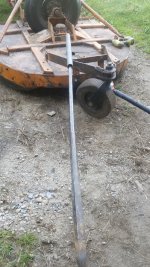Well everybody, I got busy with 2nd cut hay and didn't have a chance to use the brush hog until the day before yesterday. What seemed to be the issue was that I was under-torquing the nuts. Apparently 4 feet of leverage wasn't enough. I put a rock bar in the open end of the pipe to increase leverage to ~9ft and tightened the **** out of both nuts, as well as reapplying loctite, still with the nord-lock washers installed. So far the nuts are staying tight as can be after taking out some bushes, small trees, and hitting quite a few rocks. Now to address some more specific comments:
jstpssng, I misspoke and was referring to the whole spinning hub as the stump jumper. You are correct, there is a large plate that the blades connect to which the stump jumper goes over. Both of those 3/8" plates are welded to the hub.
Gordon Gould, I was thinking it may have had something to do with the sandwiched plates deforming and allowing the nut to loosen. Maybe that was part of the issue but tightening the nuts to an incredibly high torque "pre-deformed" the plates?
Fuddy, I don't have threads for a 2nd nut or that would have been one of my first solutions.
Radios, one thing I was going for was keeping off the shelf bolts and nuts if possible. My local Tractor Supply has the bolt/nut set I am currently using.
As far as the whole grade 5/grade 8 debacle, I'm a mechanical engineer who grew up on a farm, so I have some experience there. Grade 5s are used in suspension and safety critical places because they STRETCH and give warning before a failure. They also commonly use grade 5 bolts for tightening heads to an engine block as they stretch predictably (torque to yield). Grade 8 will break swiftly and with little deformation, but are much harder to deform and break. All of the rotary mower bolt/nut sets from tractor supply that I have looked at specify grade 8 (e.g. ATRC�11 Blade Bolt Kit at Tractor Supply Co.). Of course, even among grade 5/grade 8 there are different types of steel/hardnesses that can be used as all that the "grade" specifies is minimum yield strength.
jstpssng, I misspoke and was referring to the whole spinning hub as the stump jumper. You are correct, there is a large plate that the blades connect to which the stump jumper goes over. Both of those 3/8" plates are welded to the hub.
Gordon Gould, I was thinking it may have had something to do with the sandwiched plates deforming and allowing the nut to loosen. Maybe that was part of the issue but tightening the nuts to an incredibly high torque "pre-deformed" the plates?
Fuddy, I don't have threads for a 2nd nut or that would have been one of my first solutions.
Radios, one thing I was going for was keeping off the shelf bolts and nuts if possible. My local Tractor Supply has the bolt/nut set I am currently using.
As far as the whole grade 5/grade 8 debacle, I'm a mechanical engineer who grew up on a farm, so I have some experience there. Grade 5s are used in suspension and safety critical places because they STRETCH and give warning before a failure. They also commonly use grade 5 bolts for tightening heads to an engine block as they stretch predictably (torque to yield). Grade 8 will break swiftly and with little deformation, but are much harder to deform and break. All of the rotary mower bolt/nut sets from tractor supply that I have looked at specify grade 8 (e.g. ATRC�11 Blade Bolt Kit at Tractor Supply Co.). Of course, even among grade 5/grade 8 there are different types of steel/hardnesses that can be used as all that the "grade" specifies is minimum yield strength.


